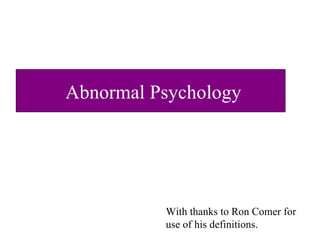
Mediaabnormal
- 1. Abnormal Psychology With thanks to Ron Comer for use of his definitions.
- 4. Defining Mental Disorder No Mild Moderate Severe Disorder Disorder Disorder Disorder
- 8. Defining Mental Disorder Homosexuality was defined as a disorder in previous DSM Manuals
- 9. Defining Mental Disorder It is current practice in China to institutionalize members of the Falun Gong religion
- 10. Defining Mental Disorder Sarafem – another name for Prozac
- 12. Personality Disorders Inflexible pattern of inner experience and outward behavior which deviates markedly from one’s culture. Paranoid, Schizoid, Antisocial , Borderline , Narcissistic, Histrionic, Avoidant, Dependent
- 13. Antisocial Personality Shows a pervasive pattern of disregard for, and violation of other people’s rights. Up to 3.5% manifest an antisocial personality disorder (APA, 1994) Symptoms: Repeatedly deceitful, irresponsible with money, impulsive, tendency to start fights, egocentric, no regard for safety of self or others.
- 14. Antisocial Personality Tend to be skillful at manipulating people. Are not distressed by the pain they cause, often perceived as lacking any moral conscience. “ They glibly rationalize their actions by characterizing their victims as weak and deserving of being conned or stolen from” (Comer, 1997)
- 15. Borderline Personality Characterized by mood shifts, unstable self-image, and impulsivity. 2% of the U.S. population suffer from Borderline personality disorder (APA, 1994). Symptoms: Intense, conflict filled relationships, overstep relationship boundaries, fear of desertion, suicidal thoughts, self-mutilation, emptiness, boredom, confusion about identity.
- 17. Generalized Anxiety Disorder General “free floating” anxiety about everything 3.8% of the U.S. population exhibit symptoms (APA, 1994). Symptoms: Restlessness, Quick to Fatigue, Trouble Concentrating, Irritability, Muscle Tension, Sleep Problems.
- 18. Phobia Persistent and unreasonable fear of a particular object 10-11% of the U.S. population exhibit symptoms (Magee et al., 1996). Common Phobias: Heights, Death, Snakes, Interacting with others, Crowds, injections, doctors, spiders, flying.
- 19. Phobia Luposlipaphobia : The fear of being pursued by timber wolves around a kitchen table while wearing socks on a newly waxed floor (Gary Larson, the far side)
- 20. Panic Disorders Periodic, discrete bouts of panic that occur abruptly and peak within 10 minutes 2.3 % of the U.S. population suffer from Panic Disorder (Weissman et al., 1997) Symptoms: Palpitations of the heart, shortness of breath, chest pains, choking sensation, faintness, dizziness
- 21. Obsessive Compulsive Disorder Obsession – Persistent thoughts, ideas, impulses, or images that invade consciousness Compulsion – Repetitive and rigid behaviors or mental acts that a person feels compelled to perform to reduce distress 2% of the U.S. population suffer from OCD (APA, 1994).
- 22. PTSD Distinct patterns of behavior that arise in reaction to a psychologically traumatic event. 7.8% of U.S. population will experience at least one episode in their lifetime Symptoms: Re-experiencing traumatic event, avoidance, reduced responsiveness, increased arousal (anxiety/guilt)
- 24. Unipolar Depression Severe, long lasting, and debilitating sadness. 5-10% of the U.S. population experiences clinical depression in a given year (Kessler et al, 1994) Symptoms: Feelings of sadness, loss of sense of humor, lack of drive, suicidal thoughts, anxiety, staying in bed, easily distracted
- 25. Bipolar Depression Depressive episodes followed by manic episodes. Mania – dramatic and inappropriate elevations of mood. 1.5% of the U.S. population suffers from bipolar depression (Kessler et al, 1994) Symptoms: hyperactivity, insomnia, arbitrary decision making, delusions.
- 26. Other Disorders Memory disorders (Alzheimer’s, Amnesia, Korsakoff’s ) Perceptual disorders (Agnosia, Prosopagnosia, Neglect, Balint’s) Language disorders (Broca’s Aphasia, Wernicke’s Aphasia) Physical Disorders (Anorexia, Bulimia, Obesity) Misc. (Phantom Limb, Imposter Effect, Autism, Schizophrenia)
- 28. Why would somebody be afraid of white furry objects? Behavioral Therapy
- 29. Systematic Desensitization Behavioral Therapy
- 31. Aversion Therapy Ipecac Alcohol + + = = Sobriety Behavioral Therapy
- 32. Other Behavioral Therapies Social Learning Therapy Operant Conditioning Therapy Behavioral Therapy
- 33. Constant Repetition of Negative thoughts leads to abnormality Cognitive Therapy
- 34. Nobody likes me Even people who like me occasionally get mad at me I’m a moron I’m smart, even if I do make mistakes now and then I’m worthless I’m a good person My jokes are bad It’s not my fault that the class has no sense of humor. Cognitive Therapy
- 35. Freud and his famous couch Psychoanalytic Therapy
- 36. Freud saw many things as having sexual overtones Psychoanalytic Therapy
- 37. Carl Jung Collective Unconcious and Archetypes The shadow archetype Psychoanalytic Therapy
- 38. The patient best knows his or her own mind, the psychologist’s job is to facilitate self-therapy Eliza the Online Therapist Humanistic Therapy
- 43. Electroconvulsive Therapy Induce small seizures to correct for chemical imbalances Biomedical Therapy